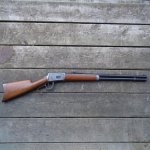I read about the Remington 1100 tests done in 1978 , where an 1100 was tested for function , to see how many shots it would cycle without a malfunction , and absolutley no cleaning.
It apparently set a record that stands unbroken to this day . 24,000 . Thats quite an achievement !
Then I got to thinking , about the the Winchester 94's. How many shots would be a normal life expectancy for one of these? Kept clean , oiled , and maintained properly. How many shots would one last ? What would be the life expectancy in rounds?
I know there has been millions of them produced , and many are getting to be quite old , but age alone doesnt add any wear to a gun. A gun could sit in a closset for 25 years and never be fired.
I wonder if there has been any tests done , to find out how many shots one actually lasts?
What parts usually failed first , that kind of thing. I'd be interested if someone has any data?
It apparently set a record that stands unbroken to this day . 24,000 . Thats quite an achievement !
Then I got to thinking , about the the Winchester 94's. How many shots would be a normal life expectancy for one of these? Kept clean , oiled , and maintained properly. How many shots would one last ? What would be the life expectancy in rounds?
I know there has been millions of them produced , and many are getting to be quite old , but age alone doesnt add any wear to a gun. A gun could sit in a closset for 25 years and never be fired.
I wonder if there has been any tests done , to find out how many shots one actually lasts?
What parts usually failed first , that kind of thing. I'd be interested if someone has any data?








































































